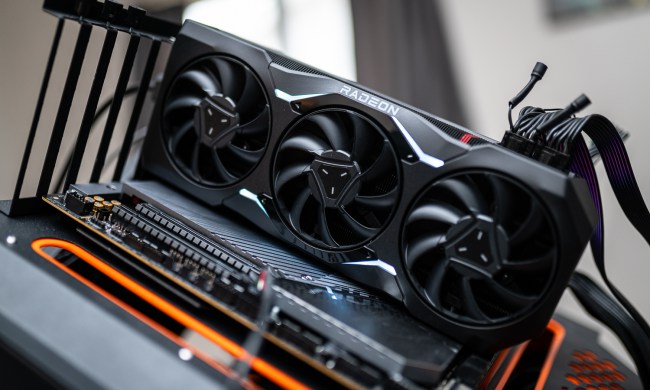During its analyst day, AMD announced it’s ready to take on rival Nvidia in the high-end, performance gaming segment, and it will launch a line of graphics card that can deliver ray tracing, 4K resolution, and 3D audio support.
“We’re on the cusp of the next generation graphics and the next generation consoles,” said Rick Bergman, AMD’s executive vice president of Computing and Graphics. “We will use our latest technology, and our latest RDNA technology as well, creating this very immersive experience with ray tracing, 3D audio, and fast load times that will excite a new generation of gamers.”
Unlike AMD’s current crop of graphics cards, which rely on the first generation of RDNA technology, the new graphics cards slated for a debut towards the end of this year will rely on RDNA 2 backed by the company’s Navi 2 architecture.
While AMD has historically delivered competitive performance — its current RX 5600 and RX 5700 cards are targeted at 1080p and 1440p gamers, respectively — the new cards are aimed to make AMD more competitive in the premium GPU space, going toe-to-toe with Nvida’s RTX 2080, and its variants. Like AMD’s current graphics, RDNA 2 will be based on a 7 nanometer production process.

Bergman, and AMD CEO Lisa Su, stated this new generation of graphics will arrive on everything from PCs to consoles. RDNA 2 is slated to arrive later this year, Su said, while the new consoles will ship this holiday. AMD is working with both Microsoft and Sony on the next-generation Xbox Series X and PlayStation 5. Both consoles will feature ray tracing support.
AMD’s numbers show the current generation of RDNA architecture delivered 50 percent better performance per watt compared to the older GCN architecture. RDNA 2 is promised to deliver a similar 50 percent improvement over RDNA.

Support for variable rate shading, or VRS, is key to AMD’s pitch. Current GeForce gamers who have opted to turn on ray tracing have done so with a sacrifice in performance, but AMD claims its hardware and software-driven approach means better sustained performance with the feature turned on.
“Of course, we have to have just stunning visuals, as well as [we had] talked about the importance of ray tracing and sharing the shadows and reflections and to be able to game at a very fluid consistent rate,” Bergman said. “So I add additional features, like variable rate shading as well, to give you that performance uplift so critical to that segment of the market.”
RDNA 2 is promised to deliver a 50 percent improvement over RDNA.
In the processor space, AMD’s next generation Zen 3 chip will also be built on a 7nm process. AMD’s Zen 4 processor, which could debut in either 2021 or 2022, will be based on a 5nm process. Like AMD, rival Intel is also eyeing the 5nm process.
A fork in the road
Moving forward, AMD says its general purpose GPU architecture, or GPGPU, is no longer sufficient, and it will be migrating to domain-specific architectures that will target either gamers and creators, or compute-optimized architectures for data centers.

Gamers will continue to rely on AMD’s investment in its Radeon DNA, or RDNA, for graphics. Other use cases will be addressed by CDNA, or computer-optimized DNA, which targets data centers and makes scalability a priority.
The new CDNA architecture will target high performance computing with tensor operations, and AMD will combine its expertise with CPUs, GPUs, and software to deliver better performance and scalability. CDNA will be the path forward for AMD as it moves towards exascale supercomputers, like the new El Capitan system announced by the Department of Energy’s Lawrence Livermore Labs.
Price and availability
AMD did not reveal any specific price or availability information about new RDNA2 graphics cards, or game consoles that will use the architecture. RDNA2 hardware, including new game consoles like the Xbox Series X and PlayStation 5, are slated to arrive sometime in late 2020.



